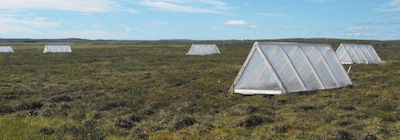
Researchers erected these plastic greenhouses on the hummock tundra near Daring Lake, ~300 km north of Yellowknife, NWT to see which shrubs would be favoured by warmer temperatures. (Credit: Paul Grogan, Queen’s University)
As the Arctic tundra warms, will fast-growing leafy plants come to dominate the landscape, or will they lose out to the slow-but-steady evergreens?
The results of a 8-year experiment using plastic greenhouses to simulate warmer temperatures seem to indicate the latter. Even though deciduous trees are better at exploiting fertile environments, the tougher evergreens grew 66% to 82% better in the dry, nutrient-poor soils that currently extend over large areas of the Arctic.
Original research paper published in the Journal of Ecology on March 21, 2014.
Names and affiliations of selected authors
